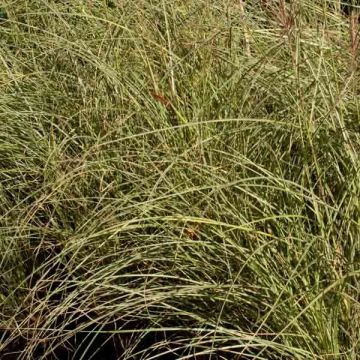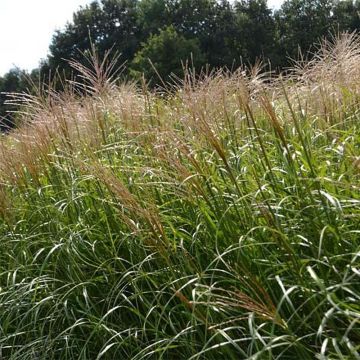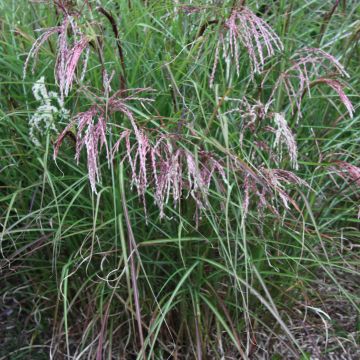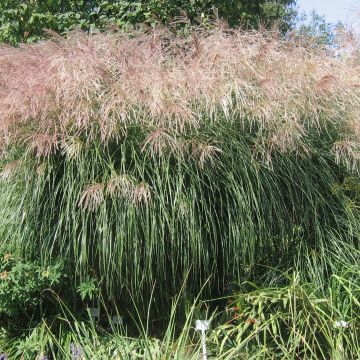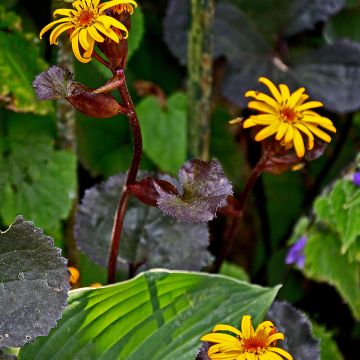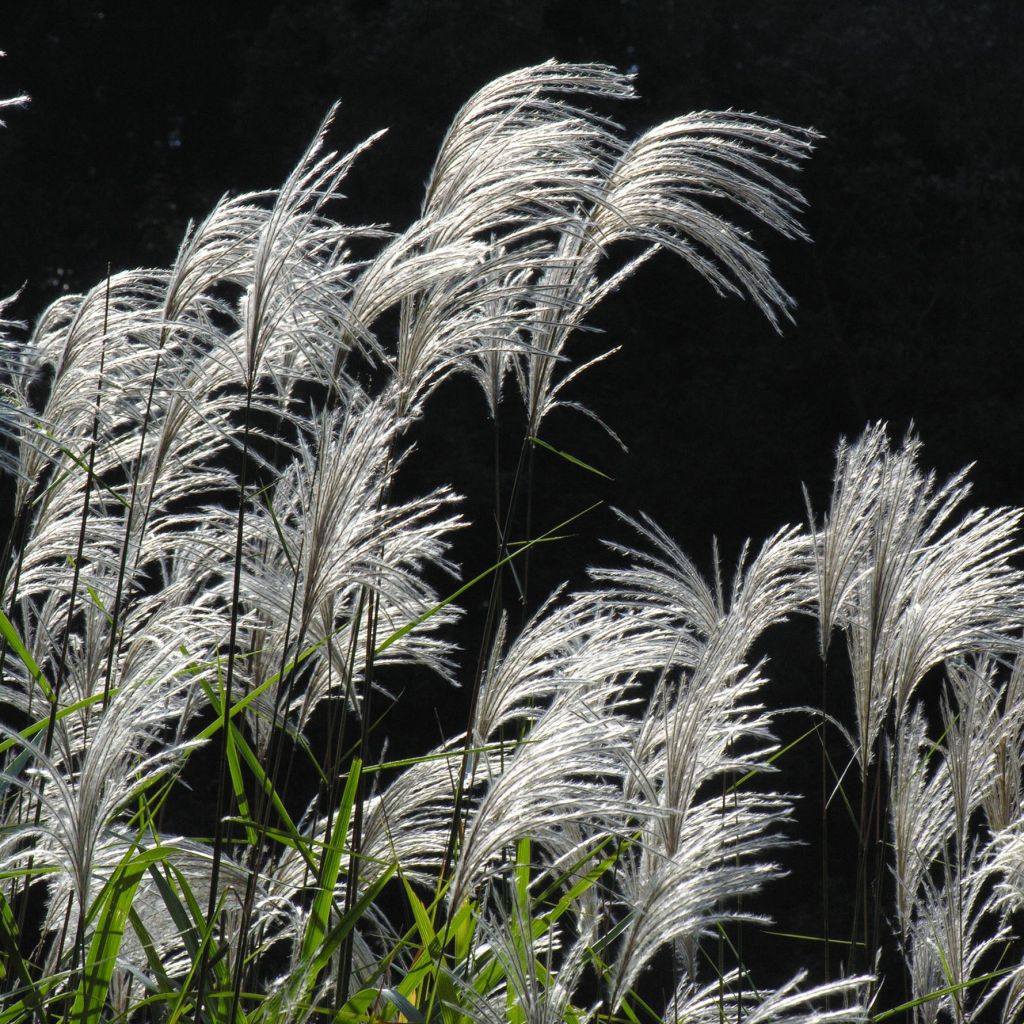

Miscanthus sacchariflorus


Miscanthus sacchariflorus
Miscanthus sacchariflorus
Miscanthus sacchariflorus
Amur Silvergrass, Japanese Silvergrass, Maiden Grass, Eulalia Grass, Zebra Grass, Silver Chinese Reed
This item cannot be shipped to the selected country
Delivery charge from €5.90
Delivery charge from €5.90
More information
Schedule delivery date,
and select date in basket
This plant carries a 12 months recovery warranty
More information
We guarantee the quality of our plants for a full growing cycle, and will replace at our expense any plant that fails to recover under normal climatic and planting conditions.
From €5.90 for pickup delivery and €6.90 for home delivery
Express home delivery from €8.90.
From €5.90 for pickup delivery and €6.90 for home delivery
Express home delivery from €8.90.
Does this plant fit my garden?
Set up your Plantfit profile →
Description
Miscanthus sacchariflorus, also known as Chinese reed or Eulalia, is distinguished by its wide foliage marked with brown and silver throughout its length, and by its flowering forming a silky cascade of feathery and silver spikes with light red reflections, in late summer. It is a generous grass, which should be given some space to develop its foliage, which will ignite early in autumn. Exotic, sculptural, and wild, its strong presence blends with gardens of all styles, integrating with hedgerows, or standing out in large pots on a patio. Just place it in the sun in ordinary soil, which remains moist in summer.
Miscanthus sacchariflorus is a perennial plant of the Poaceae family, native to East Asia, the Soviet Far East, and China, but naturalised in North America. It is hardy down to at least -25°C (-13°F). It forms a strong tuft with a slightly loose habit, reaching 1.6 to 2m (5 to 7ft) in height when flowering, with foliage remaining at 80cm (32in) from the ground, occupying a similar width. Its growth is quite fast in fertile soil, supported by long, thin, scaly rhizomes that allow it to slowly spread. The very decorative glaucous green foliage is traversed by a silver midrib and brown longitudinal lines. It consists of ribbon-like leaves, which are rather wide and flexible. They take on a beautiful coppery to orange hue from the end of summer. Flowering begins in August, emerging well above the foliage at the end of numerous graceful culms. It then elongates in a spectacular manner, reaching 10 to 35cm (4 to 14in) in length, with very silky silver spikes, slightly tinged with coppery red at maturity. This plant undoubtedly offers one of the most beautiful flowers of the miscanthus genus. This grass is not invasive.
With the perfect combination of soft silver plumes dancing on the coppery ribbons of its foliage, Miscanthus sacchariflorus attracts all eyes in late summer. It deserves some space to express its full potential at the back of a bed. It can planted en masse to create a large border, or to form a screen using taller varieties like Miscanthus sinensis 'Goliath' at the edge of the garden. This beautiful green screen will enhance flowering shrubs and autumn foliage. Two plants placed face to face can mark a doorway, for example, in an original and natural way. Take advantage of its fountain-like habit to display it on a slightly elevated area, such as a large embankment or incline, combined with the autumn blooms of asters (Aster laevis 'Calliope', Aster turbinellus, Aster cordifolius) or sunflowers (Helianthus maximiliani, Helianthus salicifolius, Helianthus atrorubens). It pairs well with Perovskia and Stipa arundinacea, autumn daisies, Japanese anemones, and perennial chrysanthemums.
Report an error about the product description
Miscanthus sacchariflorus in pictures




Flowering
Foliage
Plant habit
Botanical data
Miscanthus
sacchariflorus
Poaceae
Amur Silvergrass, Japanese Silvergrass, Maiden Grass, Eulalia Grass, Zebra Grass, Silver Chinese Reed
East Asia
Other Miscanthus
Planting and care
Miscanthus sacchariflorus thrives in warm exposures. It prefers fairly rich and deep well-drained soil that remains moist in summer. It tolerates some drought once well-established. It can adapt to poor soils, but its growth will be slower and less spectacular. Prune the floral stems in spring.
Planting period
Intended location
Care
-
, onOrder confirmed
Reply from on Promesse de fleurs
Coloured foliage perennials
Haven't found what you were looking for?
Hardiness is the lowest winter temperature a plant can endure without suffering serious damage or even dying. However, hardiness is affected by location (a sheltered area, such as a patio), protection (winter cover) and soil type (hardiness is improved by well-drained soil).

Photo Sharing Terms & Conditions
In order to encourage gardeners to interact and share their experiences, Promesse de fleurs offers various media enabling content to be uploaded onto its Site - in particular via the ‘Photo sharing’ module.
The User agrees to refrain from:
- Posting any content that is illegal, prejudicial, insulting, racist, inciteful to hatred, revisionist, contrary to public decency, that infringes on privacy or on the privacy rights of third parties, in particular the publicity rights of persons and goods, intellectual property rights, or the right to privacy.
- Submitting content on behalf of a third party;
- Impersonate the identity of a third party and/or publish any personal information about a third party;
In general, the User undertakes to refrain from any unethical behaviour.
All Content (in particular text, comments, files, images, photos, videos, creative works, etc.), which may be subject to property or intellectual property rights, image or other private rights, shall remain the property of the User, subject to the limited rights granted by the terms of the licence granted by Promesse de fleurs as stated below. Users are at liberty to publish or not to publish such Content on the Site, notably via the ‘Photo Sharing’ facility, and accept that this Content shall be made public and freely accessible, notably on the Internet.
Users further acknowledge, undertake to have ,and guarantee that they hold all necessary rights and permissions to publish such material on the Site, in particular with regard to the legislation in force pertaining to any privacy, property, intellectual property, image, or contractual rights, or rights of any other nature. By publishing such Content on the Site, Users acknowledge accepting full liability as publishers of the Content within the meaning of the law, and grant Promesse de fleurs, free of charge, an inclusive, worldwide licence for the said Content for the entire duration of its publication, including all reproduction, representation, up/downloading, displaying, performing, transmission, and storage rights.
Users also grant permission for their name to be linked to the Content and accept that this link may not always be made available.
By engaging in posting material, Users consent to their Content becoming automatically accessible on the Internet, in particular on other sites and/or blogs and/or web pages of the Promesse de fleurs site, including in particular social pages and the Promesse de fleurs catalogue.
Users may secure the removal of entrusted content free of charge by issuing a simple request via our contact form.
The flowering period indicated on our website applies to countries and regions located in USDA zone 8 (France, the United Kingdom, Ireland, the Netherlands, etc.)
It will vary according to where you live:
- In zones 9 to 10 (Italy, Spain, Greece, etc.), flowering will occur about 2 to 4 weeks earlier.
- In zones 6 to 7 (Germany, Poland, Slovenia, and lower mountainous regions), flowering will be delayed by 2 to 3 weeks.
- In zone 5 (Central Europe, Scandinavia), blooming will be delayed by 3 to 5 weeks.
In temperate climates, pruning of spring-flowering shrubs (forsythia, spireas, etc.) should be done just after flowering.
Pruning of summer-flowering shrubs (Indian Lilac, Perovskia, etc.) can be done in winter or spring.
In cold regions as well as with frost-sensitive plants, avoid pruning too early when severe frosts may still occur.
The planting period indicated on our website applies to countries and regions located in USDA zone 8 (France, United Kingdom, Ireland, Netherlands).
It will vary according to where you live:
- In Mediterranean zones (Marseille, Madrid, Milan, etc.), autumn and winter are the best planting periods.
- In continental zones (Strasbourg, Munich, Vienna, etc.), delay planting by 2 to 3 weeks in spring and bring it forward by 2 to 4 weeks in autumn.
- In mountainous regions (the Alps, Pyrenees, Carpathians, etc.), it is best to plant in late spring (May-June) or late summer (August-September).
The harvesting period indicated on our website applies to countries and regions in USDA zone 8 (France, England, Ireland, the Netherlands).
In colder areas (Scandinavia, Poland, Austria...) fruit and vegetable harvests are likely to be delayed by 3-4 weeks.
In warmer areas (Italy, Spain, Greece, etc.), harvesting will probably take place earlier, depending on weather conditions.
The sowing periods indicated on our website apply to countries and regions within USDA Zone 8 (France, UK, Ireland, Netherlands).
In colder areas (Scandinavia, Poland, Austria...), delay any outdoor sowing by 3-4 weeks, or sow under glass.
In warmer climes (Italy, Spain, Greece, etc.), bring outdoor sowing forward by a few weeks.

































